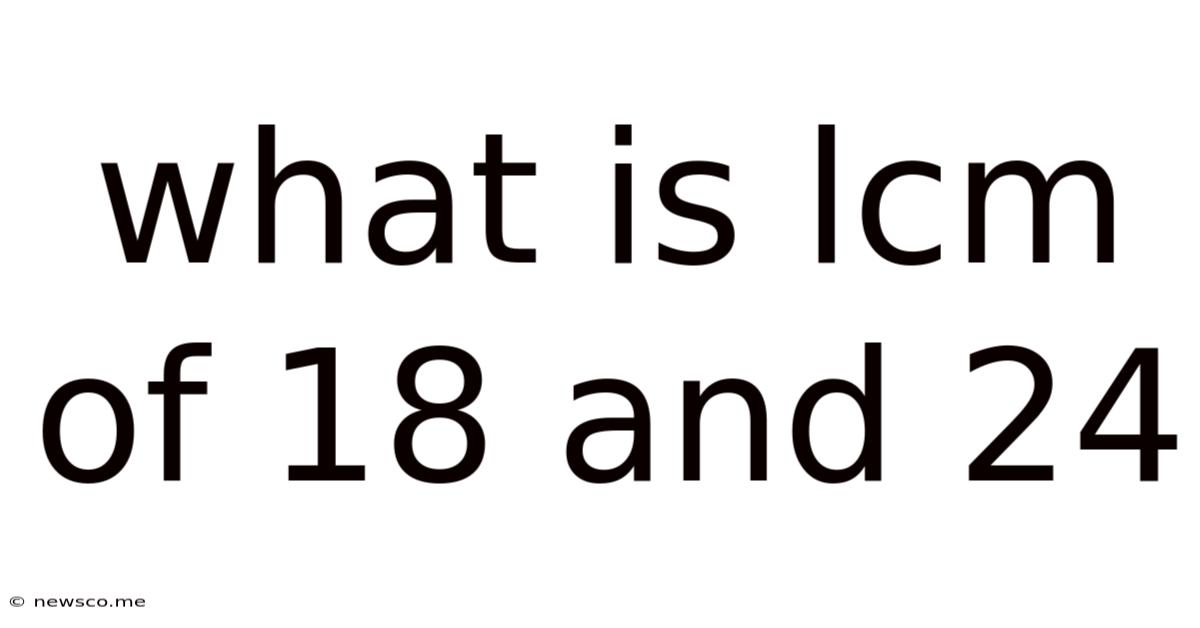What Is Lcm Of 18 And 24
News Co
Mar 20, 2025 · 5 min read

Table of Contents
What is the LCM of 18 and 24? A Deep Dive into Least Common Multiples
Finding the least common multiple (LCM) of two numbers is a fundamental concept in mathematics, crucial for various applications from simplifying fractions to solving complex problems in algebra and beyond. This article provides a comprehensive exploration of how to find the LCM of 18 and 24, detailing multiple methods and expanding on the underlying mathematical principles. We'll also delve into the practical significance of LCMs and how they're used in different contexts.
Understanding Least Common Multiples (LCM)
Before we tackle the specific problem of finding the LCM of 18 and 24, let's solidify our understanding of what an LCM actually is. The least common multiple of two or more integers is the smallest positive integer that is a multiple of all the numbers. In simpler terms, it's the smallest number that can be divided evenly by both (or all) of the given numbers without leaving a remainder.
For example, consider the numbers 4 and 6. The multiples of 4 are 4, 8, 12, 16, 20, 24, ... and the multiples of 6 are 6, 12, 18, 24, 30, ... Notice that 12 and 24 are common multiples of both 4 and 6. However, 12 is the smallest such number, making it the least common multiple (LCM) of 4 and 6.
Method 1: Listing Multiples
One straightforward approach to finding the LCM is by listing the multiples of each number until a common multiple is found. This method is particularly useful for smaller numbers.
Let's apply this to find the LCM of 18 and 24:
Multiples of 18: 18, 36, 54, 72, 90, 108, 126, 144, ...
Multiples of 24: 24, 48, 72, 96, 120, 144, ...
By comparing the lists, we can see that 72 and 144 are common multiples. However, 72 is the smallest common multiple, therefore, the LCM of 18 and 24 is 72.
This method, while simple, can become cumbersome and time-consuming for larger numbers. Let's explore more efficient methods.
Method 2: Prime Factorization
Prime factorization is a powerful technique for finding the LCM of larger numbers. It involves breaking down each number into its prime factors – numbers divisible only by 1 and themselves.
Let's find the prime factorization of 18 and 24:
- 18: 2 x 3 x 3 = 2 x 3²
- 24: 2 x 2 x 2 x 3 = 2³ x 3
To find the LCM using prime factorization:
- Identify the prime factors: We have 2 and 3.
- Take the highest power of each prime factor: The highest power of 2 is 2³ (from 24), and the highest power of 3 is 3² (from 18).
- Multiply the highest powers together: 2³ x 3² = 8 x 9 = 72
Therefore, the LCM of 18 and 24, using prime factorization, is 72. This method is significantly more efficient than listing multiples, especially when dealing with larger numbers.
Method 3: Greatest Common Divisor (GCD) Method
The greatest common divisor (GCD) is the largest number that divides evenly into both numbers. There's a relationship between the LCM and GCD of two numbers:
LCM(a, b) x GCD(a, b) = a x b
Let's find the GCD of 18 and 24 using the Euclidean algorithm:
- Divide the larger number (24) by the smaller number (18): 24 ÷ 18 = 1 with a remainder of 6.
- Replace the larger number with the smaller number (18) and the smaller number with the remainder (6): 18 ÷ 6 = 3 with a remainder of 0.
- Since the remainder is 0, the GCD is the last non-zero remainder, which is 6.
Now, we can use the formula:
LCM(18, 24) = (18 x 24) / GCD(18, 24) = (18 x 24) / 6 = 72
Therefore, the LCM of 18 and 24, using the GCD method, is 72. This method is also efficient and provides a concise solution.
Practical Applications of LCM
The concept of LCM finds widespread application in various fields:
-
Fraction Addition and Subtraction: Finding a common denominator when adding or subtracting fractions requires determining the LCM of the denominators.
-
Scheduling Problems: Determining when events will occur simultaneously, such as the meeting of two buses at a bus stop, requires finding the LCM of their individual schedules.
-
Cyclic Processes: LCM plays a crucial role in solving problems related to periodic or repeating events, like the synchronization of machinery or the timing of traffic lights.
Beyond Two Numbers: LCM of Multiple Numbers
The methods discussed above can be extended to find the LCM of more than two numbers. For prime factorization, you would consider all prime factors and their highest powers from all the numbers. For the GCD method, you'd need to find the GCD of all numbers iteratively and then apply the appropriate formula.
Conclusion: Mastering LCM Calculations
Finding the least common multiple is a fundamental skill with far-reaching applications. While listing multiples works well for smaller numbers, prime factorization and the GCD method offer more efficient solutions for larger numbers. Mastering these techniques is crucial for anyone working with mathematics, whether it's in school, university, or various professional fields. Understanding the underlying principles allows for a deeper appreciation of the interconnectedness of mathematical concepts and empowers you to solve a wider range of problems confidently and efficiently. Remember, the key is to choose the method best suited to the specific numbers involved – for 18 and 24, all methods lead to the same correct answer: 72.
Latest Posts
Related Post
Thank you for visiting our website which covers about What Is Lcm Of 18 And 24 . We hope the information provided has been useful to you. Feel free to contact us if you have any questions or need further assistance. See you next time and don't miss to bookmark.